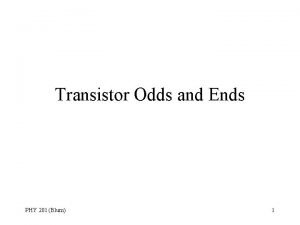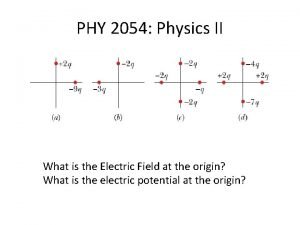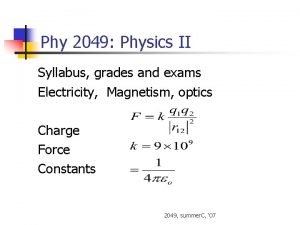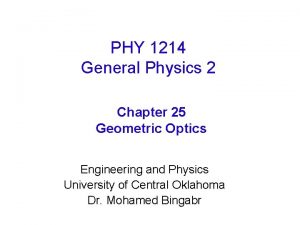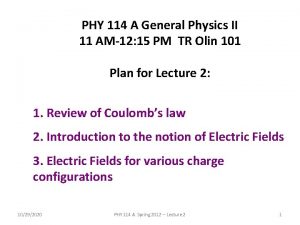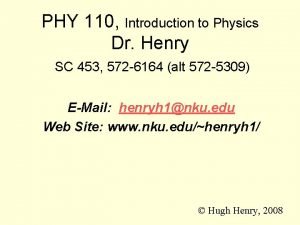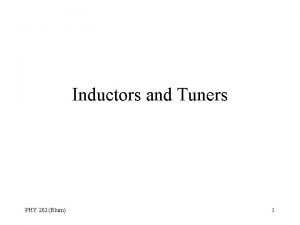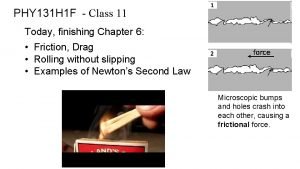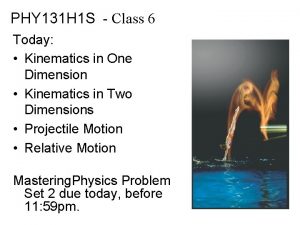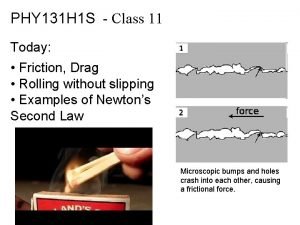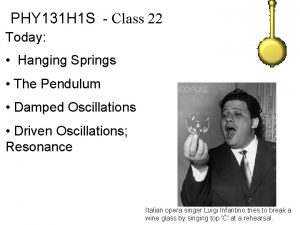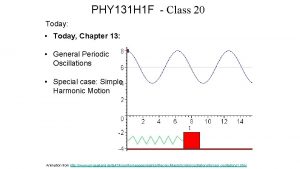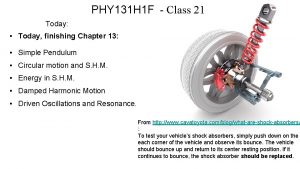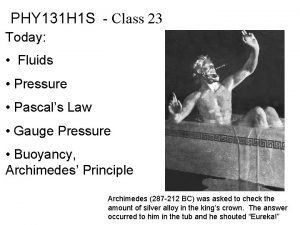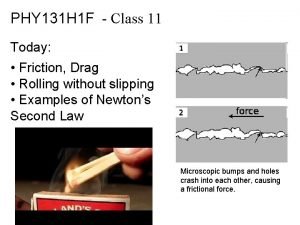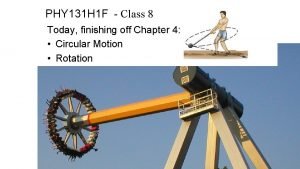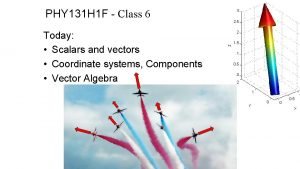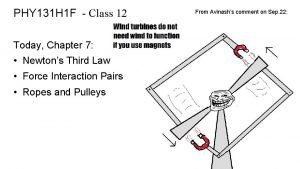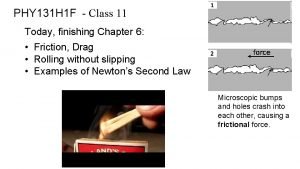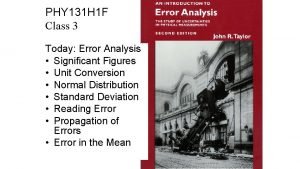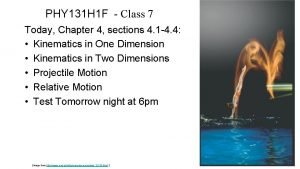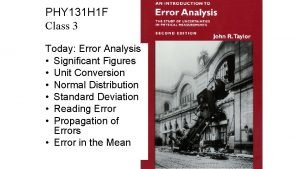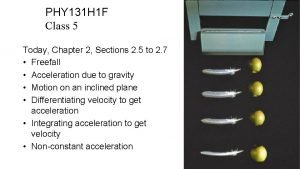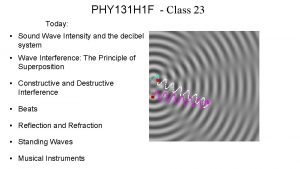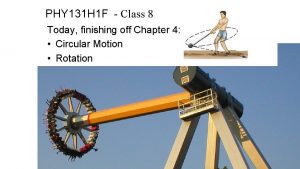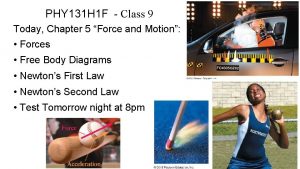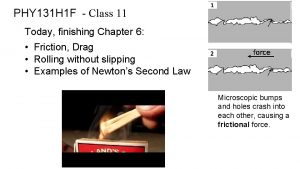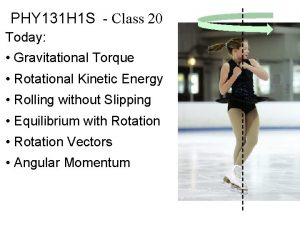PHY 131 H 1 F Class 4 Today





























- Slides: 29

PHY 131 H 1 F Class 4 Today, Chapter 2, Sections 2. 1 to 2. 4 • Uniform Motion • Average velocity / Instantaneous Velocity • Differentiating position to get velocity • Integrating velocity to get position • Equations of Constant Acceleration

Clicker Question 1 t x • If the Position versus Time graph of an object moving in 1 D is a straight line, what does this mean? A. The object is not moving B. The object is moving with a constant velocity C. The object is moving with a constant acceleration

Class 4 Preclass Quiz on Mastering. Physics § This was due this morning at 8: 00 am § 899 students submitted the quiz on time § 63% answered correctly: If the position-versus-time graph is a straight line, it means it has uniform motion. (Note: a horizontal straight line means it is stationary. ) § 72% answered correctly: Speeding up when velocity is in the negative direction means negative acceleration. § 76% answered correctly: The area under a velocity-versus-time graph is the displacement of the object (it can be negative or positive, indicating direction) § 88% answered correctly: The slope of a position-versus-time graph is the object’s velocity (it can be negative or positive, indicating forward or backward direction in 1 D)

Class 4 Preclass Quiz on Mastering. Physics § Some common student comments/feedback: § “The integral explanations were very confusing, we never learned integrals as it was not part of my grade 12 Ontario curriculum, and we haven't learned them yet in MAT 135. ” § “Integrals make me dizzy (why stop the running joke now? )” § Harlow and Meyertholen say: “We will not expect you to perform integrals on a test or exam. We use the language of calculus to describe concepts in this course, but the math you are required to do is limited to algebra, and maybe differentiation, at the most. ” § From https: //piazza. com : “Is it OK to write the derivative of a function as f ' (x)? Instead of d / dt? ”

Class 4 Preclass Quiz on Mastering. Physics § You don’t need to know this for this course, but in upper level physics courses and research, the tradition is to use primes for spatial derivatives, and dots for time derivatives. . § Feel free to use these notations if you wish; I’m sure the graders and TAs in this course will understand what you mean.

Last day I asked at the end of class: • Does constant velocity imply constant acceleration? • ANSWER: YES, and even more, it implies zero acceleration! (zero is a constant!) • Does constant acceleration imply constant velocity? • ANSWER: NO! Unless that constant happens to be zero! Constant acceleration normally means constantly changing velocity!

Uniform Motion = Constant Velocity In the absence of friction, all objects tend to move with constant velocity. This is “Newton’s First Law of Motion. ” x t

Images from http: //people. rit. edu/andpph/exhibit-8. html ; taken by Andrew Davidhazy Ball is squished External force on ball Not squished No force

http: //articles. washingtonpost. com/2013 -09 -12/national/42010179_1_heliosphere-solar-particles-charged-particles • The farthest manmade object from Earth. • Currently 125 A. U. from the Sun (Earth is 1 A. U. ) • Moving at a constant velocity in a straight line of 17 km/s through interstellar space

Clicker Question 2 • At which point is the object moving the fastest? (highest speed)

Clicker Question 3 • At which point is the object moving the to the left?

From a Past PHY 131 Test (2006): •

From a Past PHY 131 Test (2006): • How far has bird flown when Jogger and Walker meet? • Bird has constant speed, so d. B = v. B t • Need to find t. 30 km/hr 5 km/hr 10 km/hr = 3 km

Curved Line = Not-Constant Velocity x t

Clicker Question 4 • When do objects A and B have the same velocity? A. t = 0 s B. t = 1 s C. t = 3 s D. t = 5 s E. Objects A and B never have the same velocity

Clicker Question 5 Which velocity-versus-time graph goes best with the position-versus-time graph on the left?

Announcements • Pre-course diagnostic quiz on mechanics done during zeroth practical last week. • Did you miss it? Still want your 0. 25%? Here are two make-up times to choose from: • Tues Sept. 24 - 11: 10 am in MP 125 C Wed. Sept 25 - 6: 10 pm in MP 125 C

Announcements • Don’t change your Practical Section on ROSI – your TAs will never know, and you won’t get your marks! • You must go to MP 129 and fill out a form if you want to change Practical Sections. (or do the online form) • If you’ve already switched Practicals on ROSI recently and you aren’t sure if your new and old TAs have the updated information, please go to MP 129 and ask April Seeley.

University of Toronto Peer Tutoring Letter of Recognition & Certificate Looks great on your résumé or CV! Test your knowledge and review past material. ___________________________________ FREE one-on-one tutoring sessions FREE exam help sessions Tips from students who have already taken the courses. _____________________________________________________________________________________________________ Visit us at /Uof. T. peertutoring or utpt. c-ut. ca

Acceleration in 1 -D (along a line) • Velocity is the time-derivative of position. • Acceleration is the time-derivative of velocity. • S. I. unit of acceleration is m/s per second, also called m/s 2. • Acceleration is like the “speed of the speed” • Acceleration is “how fast changes!” • It is possible to be momentarily stopped (v=0) with a non-zero acceleration!

Constant Acceleration v t


Clicker Question 6 • An object has a constant velocity 10 m/s of +10 m/s for 5 seconds. • How far does the object travel over these 5 seconds? A. 10 m B. 25 m C. 50 m D. 100 m E. 500 m v 5 s t

Clicker Question 7 • An object has an initial velocity 10 m/s of +10 m/s. • It is slowing down, with a constant value of acceleration. • After 5 seconds, it has stopped. • How far does the object travel over these 5 seconds? A. 10 m B. 25 m C. 50 m D. 100 m E. 500 m v 5 s t

Average Velocity v 10 m/s • For 1 D motion with constant acceleration, the average velocity is ½(initial velocity + final velocity) 5 s t

The 4 Equations of Constant Acceleration: 1. 2. Does not contain position! Does not contain vf ! 3. Does not contain Dt ! 4. Does not contain a ! (but you know it’s constant) Strategy: When a = constant, you can use one of these equations. Figure out which variable you don’t know and don’t care about, and use the equation which doesn’t contain it.

Example. • You are traveling at 30 m/s, and suddenly hit the brakes. • Your maximum acceleration is 10 m/s 2. • What is your minimum stopping distance?

Clicker Question 8 • You are driving along a straight highway at a steady speed. • A driver in the left lane passes you at a steady speed. • At the moment when the front of her car is exactly even with the front of your car, you both turn and your eyes meet briefly. • At this instant, do you have equal velocities? A. Yes B. No C. Not possible to determine with information given. [image downloaded Sep. 17 2013 from http: //blog. famousfootwear. com/2013/03/save-your-car-and-money-with-driving-shoes / ]

Before Class 5 on Monday • If you haven’t already done it, remember there is a Mastering. Physics. com problem set due this weekend! Please submit this before 11: 59 pm Sunday. • Please finish reading Chapter 2 of Knight. • Something to think about: Which is easier to see: velocity or acceleration? Which is easier to feel: velocity or acceleration?
 Phy 131 past papers
Phy 131 past papers Phy 131 asu
Phy 131 asu Today's class answers
Today's class answers Today meeting or today's meeting
Today meeting or today's meeting Today meeting or today's meeting
Today meeting or today's meeting Galton details
Galton details Today's lesson or today lesson
Today's lesson or today lesson Today's lesson or today lesson
Today's lesson or today lesson Pa msu
Pa msu Phy theorem
Phy theorem Rotational statics
Rotational statics Phy theorem
Phy theorem Phy 113 past questions and answers
Phy 113 past questions and answers Ddr phy architecture
Ddr phy architecture Phy 205
Phy 205 Eye accommodation
Eye accommodation Phy 2049
Phy 2049 Physics 2
Physics 2 Phy
Phy Phy
Phy Atm basics
Atm basics Fizik ii
Fizik ii Phy 2049
Phy 2049 Phy 1214
Phy 1214 Phy 1214
Phy 1214 Phy
Phy Phy 110
Phy 110 Phy
Phy Phy
Phy Life phy
Life phy



















